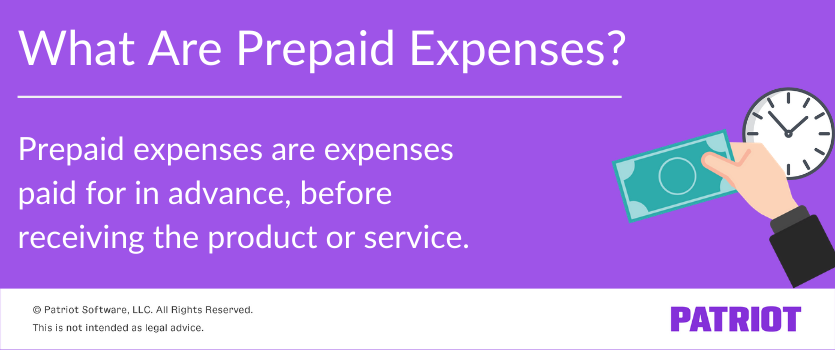Do you ever pay for business goods and services before you use them? If so, these types of purchases require special attention in your books. You need to create a prepaid expenses journal entry.
So, do you know how to record prepaid expenses? Don’t panic if you don’t. Instead, follow this simple guide to recording prepaid expenses to keep your accounting records accurate.
What are prepaid expenses?
Prepaid expenses are expenses paid for in advance. You accrue a prepaid expense when you pay for something that you will receive in the near future. Any time you pay for something before using it, you must recognize it through prepaid expenses accounting.

Prepaid expenses do not provide value right away. Instead, they provide value over time—generally over multiple accounting periods. Because the expense expires as you use it, you can’t expense the entire value of the item immediately. You can only expense the part of the expense you’ve used. Record a prepaid expense in your business financial records and adjust entries as you use the item.
The process of recording prepaid expenses only takes place in accrual accounting. If you use cash-basis accounting, you only record transactions when money physically changes hands.
What is considered a prepaid expense?
Individuals and businesses alike can accrue prepaid expenses. In small business, there are a number of purchases you may make that are considered prepaid expenses.
The following list shows common prepaid expenses examples:
- Rent (paying for a commercial space before using it)
- Small business insurance policies
- Equipment you pay for before use
- Salaries (unless you run payroll in arrears)
- Estimated taxes
- Some utility bills
- Interest expenses
Again, anything that you pay for before using is considered a prepaid expense.
What type of account is prepaid expense?
You might be wondering what type of account is a prepaid expense. As a reminder, the main types of accounts are assets, expenses, liabilities, equity, and revenue.
Maybe you’re thinking … It’s an expense, right? I mean, expense is in the title! Although that’s a fair assumption, it’s not correct.
A prepaid expense is an asset. When you initially record a prepaid expense, record it as an asset. So, where are prepaid expenses recorded? Prepaid expenses in balance sheet are listed as assets, too.
Prepaid expenses only turn into expenses when you actually use them. As you use the item, decrease the value of the asset. The value of the asset is then replaced with an actual expense recorded on the income statement.
The bottom line: Before you use a prepaid expense item, it’s an asset. Once the item is used, it is an expense.
Prepaid expenses journal entry
Create a prepaid expenses journal entry in your books at the time of purchase, before using the good or service.
Before diving into the wonderful world of journal entries, you need to understand how each main account is affected by debits and credits.
Assets and expenses are increased by debits and decreased by credits.
On the other hand, liabilities, equity, and revenue are increased by credits and decreased by debits.
To create your first journal entry for prepaid expenses, debit your Prepaid Expense account. Why? This account is an asset account, and assets are increased by debits. And for every debit, there must also be a credit. Credit the corresponding account you used to make the payment, like a Cash or Checking account. Crediting the account decreases your Cash or Checking account.
The journal entry you make when you incur the prepaid expense should look like this:
| Date | Account | Notes | Debit | Credit |
|---|---|---|---|---|
| X/XX/XXXX | Prepaid Expense | X | ||
| Cash | X |
Adjustments for prepaid expenses
Adjusting entries help balance your books. To recognize prepaid expenses that become actual expenses, use adjusting entries.
As you use the prepaid item, decrease your Prepaid Expense account and increase your actual Expense account. To do this, debit your Expense account and credit your Prepaid Expense account. This creates a prepaid expense adjusting entry.
Your journal entry reflecting the actual expense should look like this:
| Date | Account | Notes | Debit | Credit |
|---|---|---|---|---|
| X/XX/XXXX | Expense | X | ||
| Prepaid Expense | X |
Let’s say you prepay six month’s worth of rent, which adds up to $6,000. When you prepay rent, you record the entire $6,000 as an asset on the balance sheet. Each month, you reduce the asset account by the portion you use. You decrease the asset account by $1,000 ($6,000 / 6 months) and record the expense of $1,000.
Repeat the process until the expense is used up. Once you use the prepaid item, the asset account should be empty, and the Expense account should show its full value.
How to record a prepaid expense: Examples
Prepaid expense journal entries help you keep your accounting books accurate. Let’s look at some examples of prepaid expenses.
Example 1
Say you buy a one-year insurance policy for your business that costs $1,800. You pay upfront and use the insurance throughout the year.
When you buy the insurance, debit the Prepaid Expense account to show an increase in assets. And, credit the Cash account to show the loss of cash.
| Date | Account | Notes | Debit | Credit |
|---|---|---|---|---|
| X/XX/XXXX | Prepaid Expense | 1800 | ||
| Cash | 1800 |
Each month, adjust the accounts by the amount of the policy you use. Since the policy lasts one year, divide the total cost of $1,800 by 12. Adjust the accounts by $150 each month.
Expense $150 of the insurance with a debit. Reduce the Prepaid Expense account with a credit. Repeat the process each month until the policy is used and the asset account is empty.
| Date | Account | Notes | Debit | Credit |
|---|---|---|---|---|
| X/XX/XXXX | Expense | 150 | ||
| Prepaid Expense | 150 |
Example 2
You prepay $9,000 of rent for six months. You paid for the space, but you have not used it yet. So, you need to record the amount as a prepaid expense.
First, debit the Prepaid Expense account to show an increase in assets. Also, credit the Cash account to show the loss of cash.
| Date | Account | Notes | Debit | Credit |
|---|---|---|---|---|
| X/XX/XXXX | Prepaid Expense | 9000 | ||
| Cash | 9000 |
As each month passes, adjust the accounts by the amount of rent you use. Since the prepayment is for six months, divide the total cost by six ($9,000 / 6). Adjust your accounts by $1,500 each month.
Expense $1,500 of the rent with a debit. Reduce the Prepaid Expense account with a credit. Repeat the process each month until the rent is used and the asset account is empty.
| Date | Account | Notes | Debit | Credit |
|---|---|---|---|---|
| X/XX/XXXX | Expense | 1500 | ||
| Prepaid Expense | 1500 |
Looking for a simple way to record your business transactions? Look no further. Patriot’s online accounting software is easy-to-use and made for the non-accountant. Plus, we offer free, U.S.-based support. Get your free trial now!
This article has been updated from its original publication date of September 12, 2017.
This is not intended as legal advice; for more information, please click here.
